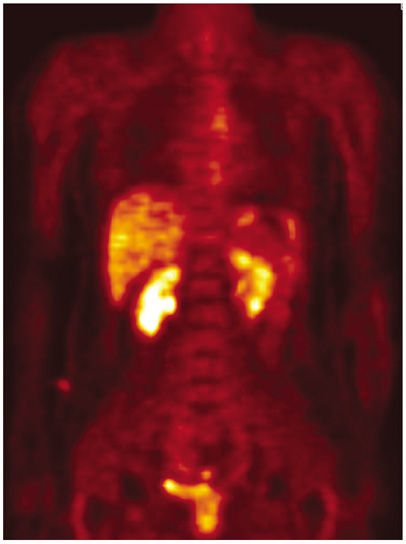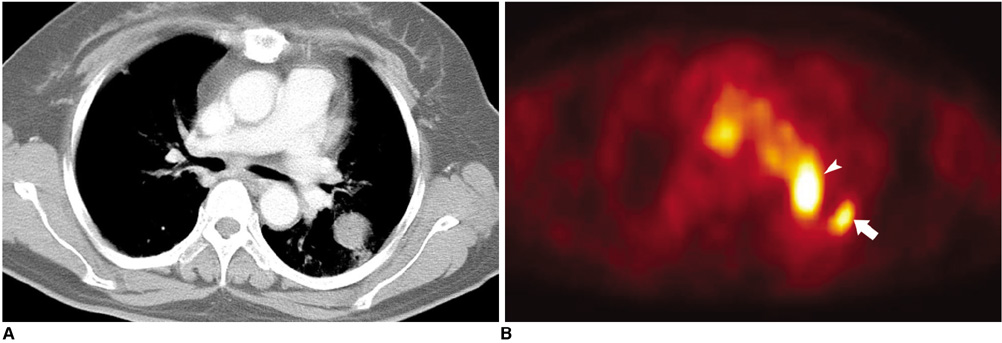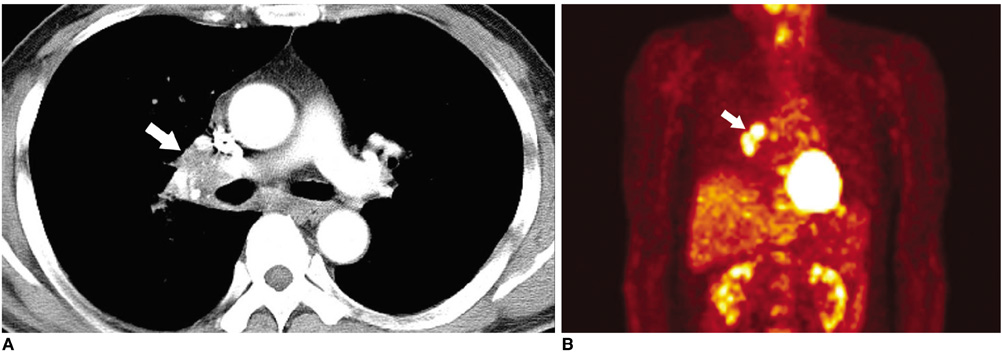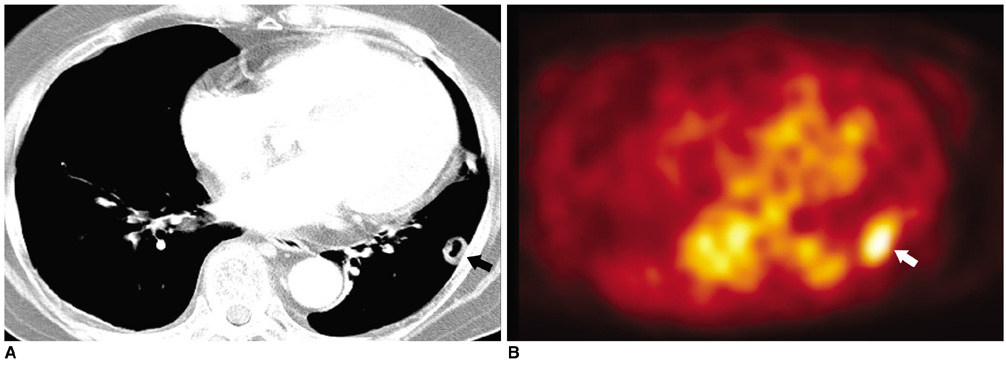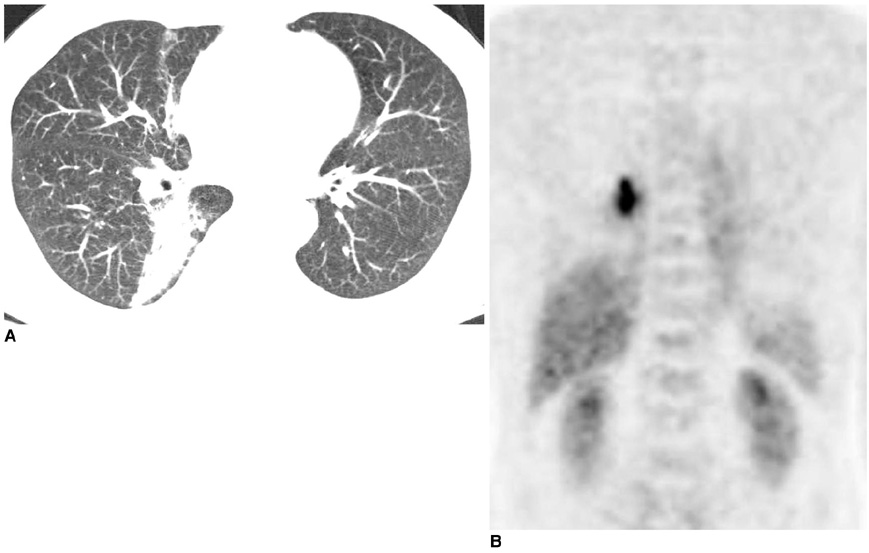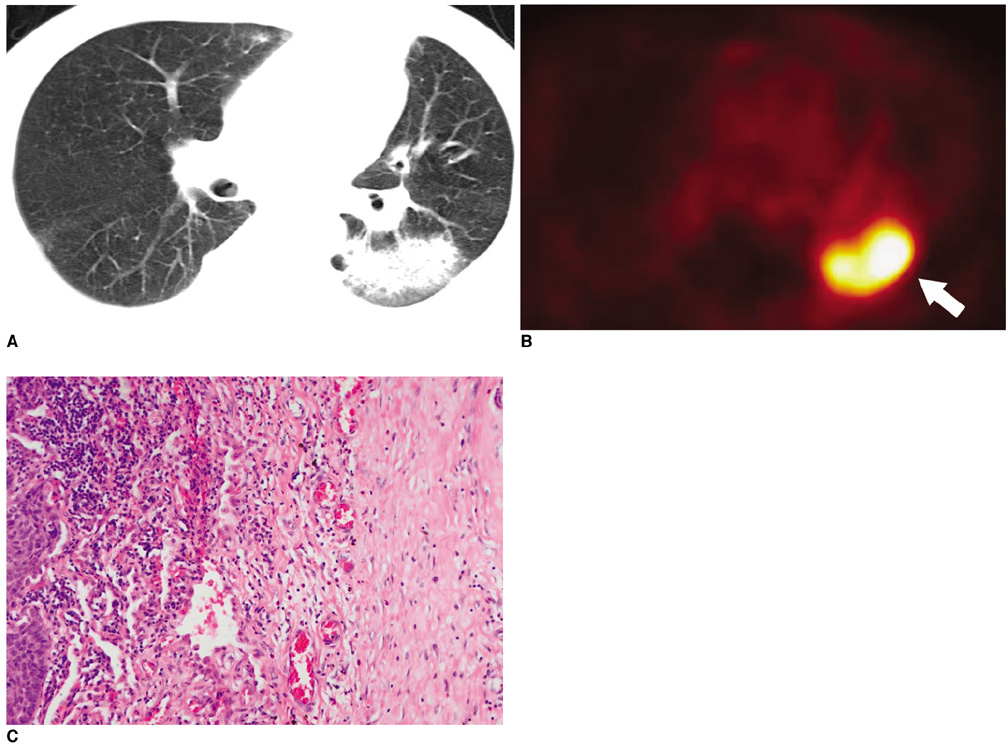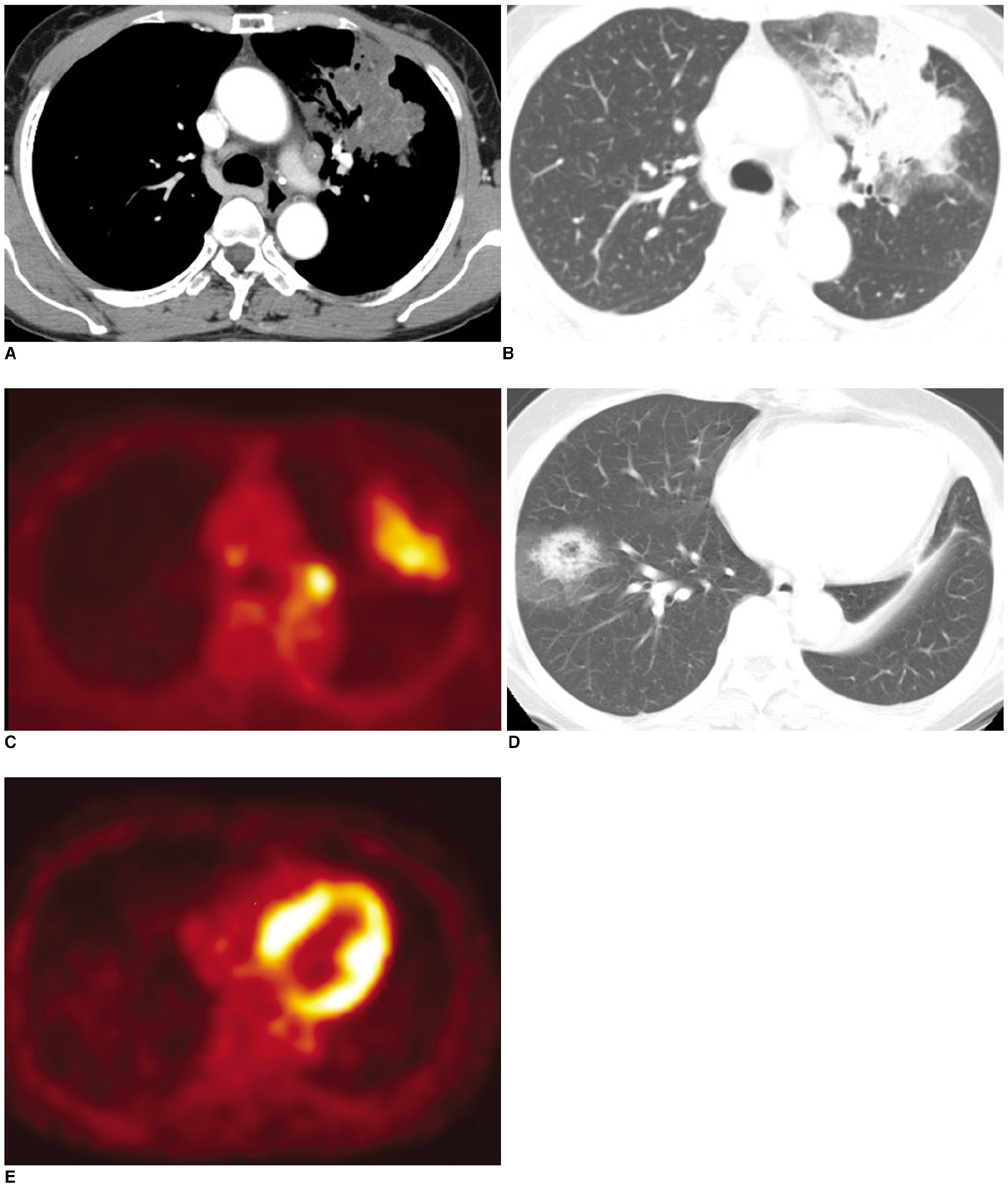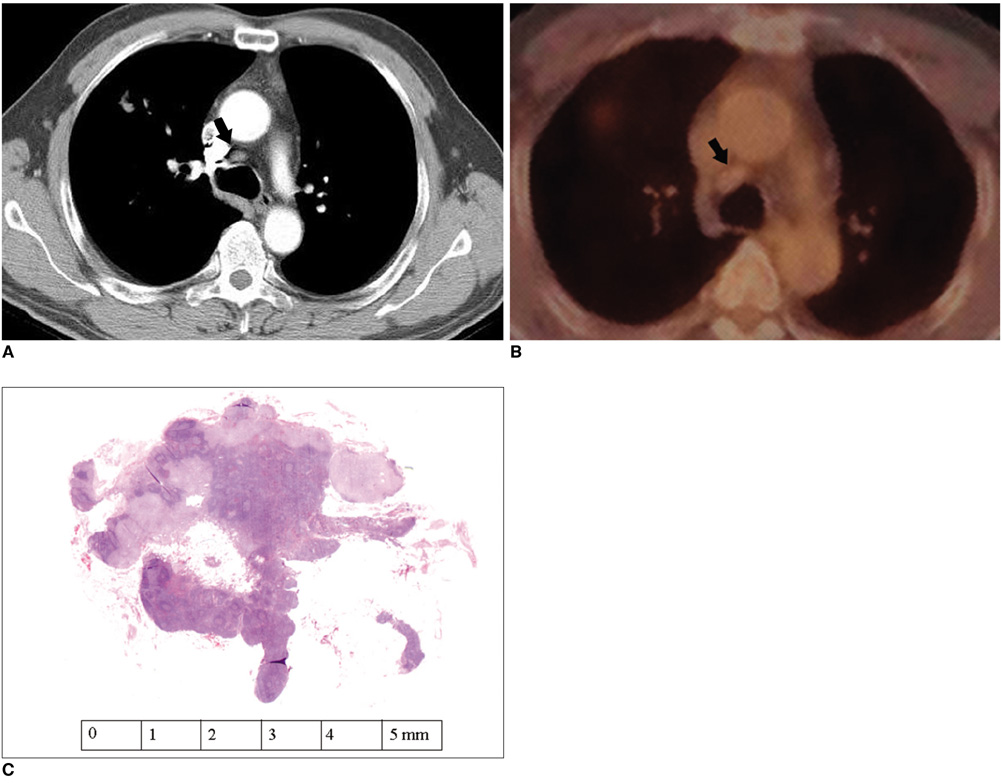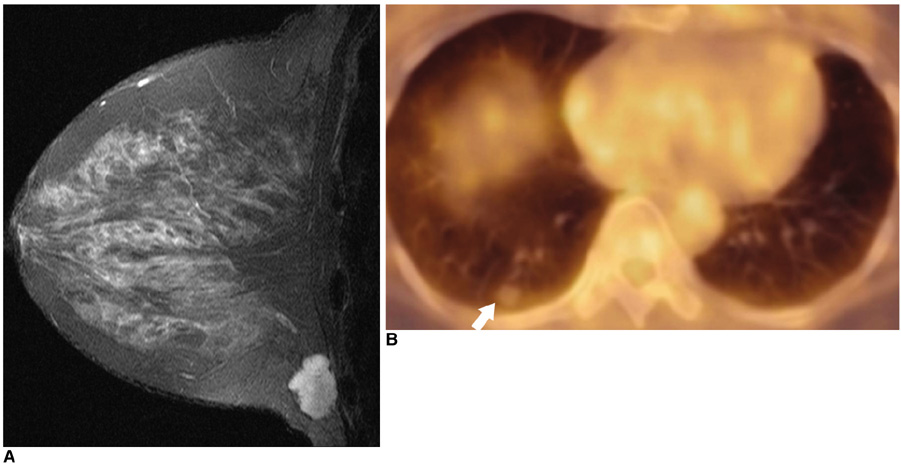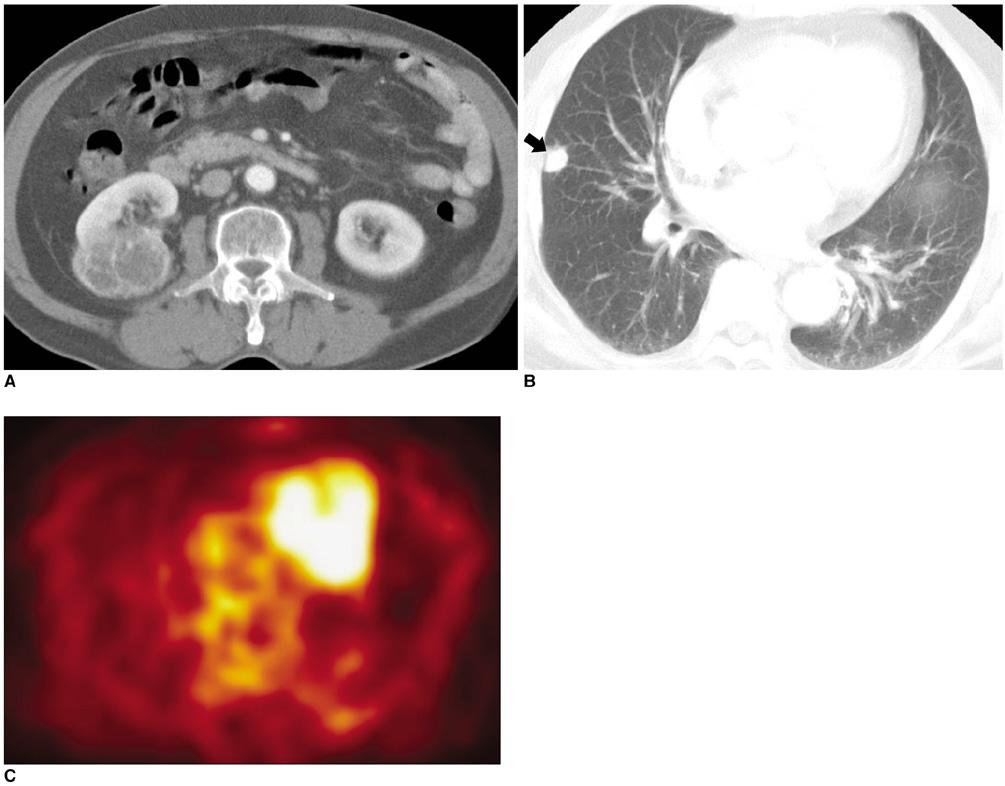False Positive and False Negative FDG-PET Scans in Various Thoracic Diseases
- Affiliations
-
- 1Department of Radiology, Seoul National University Hospital, Seoul, Korea. rosaceci@radiol.snu.ac.kr
- 2Department of Nuclear Medicine, Seoul National University Hospital, Seoul, Korea.
- KMID: 753917
- DOI: http://doi.org/10.3348/kjr.2006.7.1.57
Abstract
- Fluorodeoxyglucose (FDG)-positron emission tomography (PET) is being used more and more to differentiate benign from malignant focal lesions and it has been shown to be more efficacious than conventional chest computed tomography (CT). However, FDG is not a cancer-specific agent, and false positive findings in benign diseases have been reported. Infectious diseases (mycobacterial, fungal, bacterial infection), sarcoidosis, radiation pneumonitis and post-operative surgical conditions have shown intense uptake on PET scan. On the other hand, tumors with low glycolytic activity such as adenomas, bronchioloalveolar carcinomas, carcinoid tumors, low grade lymphomas and small sized tumors have revealed false negative findings on PET scan. Furthermore, in diseases located near the physiologic uptake sites (heart, bladder, kidney, and liver), FDG-PET should be complemented with other imaging modalities to confirm results and to minimize false negative findings. Familiarity with these false positive and negative findings will help radiologists interpret PET scans more accurately and also will help to determine the significance of the findings. In this review, we illustrate false positive and negative findings of PET scan in a variety of diseases.
MeSH Terms
-
Tuberculoma/diagnosis
Thoracic Diseases/*diagnosis
Radiopharmaceuticals/*diagnostic use
*Positron-Emission Tomography
Paragonimiasis/diagnosis
Lymphatic Diseases/diagnosis
Lung Diseases/*diagnosis
Hyperglycemia/diagnosis
Humans
Histiocytoma, Benign Fibrous/diagnosis
Fluorodeoxyglucose F18/*diagnostic use
False Positive Reactions
False Negative Reactions
Diagnosis, Differential
Cryptococcosis/diagnosis
Figure
Cited by 3 articles
-
Traumatic Neuroma at the Inferior Mesenteric Artery Stump after Rectal Cancer Surgery: A Case Report and Literature Review
Sung Mi Jeon, Jae Young Lee, Sun-Ju Byeon
Korean J Gastroenterol. 2016;68(5):279-283. doi: 10.4166/kjg.2016.68.5.279.Solitary Nodular Invasive Mucinous Adenocarcinoma of the Lung: Imaging Diagnosis Using the Morphologic-Metabolic Dissociation Sign
Min Jae Cha, Kyung Soo Lee, Tae Jung Kim, Hyun Su Kim, Tae Sung Kim, Myung Jin Chung, Byung Tae Kim, Yang Soo Kim
Korean J Radiol. 2019;20(3):513-521. doi: 10.3348/kjr.2018.0409.Computer-Aided Differential Diagnosis of the Pulmonary Nodule: Towards an Understanding of the Medical Imaging Basics and Experiences in the Field
Matvey V. Sprindzuk, Kovalev V. Alekseevich, Snezhko E. Vitalévich, Kharuzhyk S. Anatolévich
J Lung Cancer. 2009;8(2):78-91. doi: 10.6058/jlc.2009.8.2.78.
Reference
-
1. Goo JM, Im JG, Do KH, Yeo JS, Seo JB, Kim HY, et al. Pulmonary tuberculoma evaluated by means of FDG PET: findings in 10 cases. Radiology. 2000. 216:117–121.2. Kostakoglu L, Agress H, Goldsmith SJ. Clinical role of FDG PET in evalutaion of cancer patients. RadioGraphics. 2003. 23:315–340.3. Trukington TG, Coleman RE. Clinical oncologic PET: An Introduction. Semin Roentgenol. 2002. 37:102–109.4. Gupta NC, Graeber GM, Bishop HA. Comparative efficacy of positron emission tomography with fluorodeoxyglucose in evaluation of small (< 1 cm), intermediate (1 to 3 cm), and large (> 3 cm) lymph node lesions. Chest. 2000. 117:773–778.5. Alavi A, Gupta N, Alberini JL, Hickeson M, Adam LE, Bhargava P, et al. Positron emission tomography Imaging in nonmalignant thoracic disorders. Semin Nucl Med. 2002. 32:293–321.6. Amerein PC, Larson SM, Wagner HN Jr. An automated system for measurement of leukocyte metabolism. J Nucl Med. 1974. 15:352–355.7. Crystal RG . Braunwald E, Fauci AS, Kasper DL, Hauser SL, Longo DL, Jameson JL, editors. Disorders of the immune system, connective tissue, and joints, sarcoidosis. Harrison's principle of internal medicine. 2001. 15th ed. NewYork: McGraw-Hill;1969–1970.8. Bakheet SM, Powe J. Benign causes of 18-FDG uptake on whole body imaging. Semin Nucl Med. 1998. 28:352–358.9. Brudin LH, Valind SO, Rhodes CG, Pantin CF, Sweatman M, Jones T, et al. Fluorine-18 deoxyglucose uptake in sarcoidosis measured with positron emission tomography. Eur J Nucl Med. 1994. 21:297–305.10. Bennett JE. Braunwald E, Fauci AS, Kasper DL, Hauser SL, Longo DL, Jameson JL, editors. Cryptococcosis. H arrison's principle of internal medicine. 2001. 15th ed. NewYork: McGraw-Hill;1174–1175.11. Watanabe S, Nakamura Y, Kariatsumari K, Nagata T, Sakata R, Zinnouchi S, et al. Pulmonary paragonimiasis mimicking lung cancer on FDG-PET imaging. Anticancer Res. 2003. 23:3437–3440.12. Im JG, Kong Y, Shin YM, Yang SO, Song JG, Han MC, et al. Pulmonary paragonimiasis: clinical and experimental studies. RadioGraphics. 1993. 13:575–586.13. Lorenzen J, Buchert R, Bleckmann C, Munchow N, Bohuslavizki KH. A search for the focus in patients with fever of unknown origin: is positron-emission tomography with F-18-fluorodeoxyglucose helpful? Rofo Fortschr Geb Rontgenstr Neuen Bildgeb Verfahr. 1999. 171:49–53.14. Lin P, Chu J, Pocock N. Fluorine-18 FDG dual-head gamma camera coincidence imaging of radiation pneumonitis. Clin Nucl Med. 2000. 25:866–869.15. Speizer FE. Braunwald E, Fauci AS, Kasper DL, Hauser SL, Longo DL, Jameson JL, editors. Environmental lung diseases. Principle of internal medicine. 2001. 15th ed. NewYork: McGraw-Hill;1470–1471.16. Hara M, Iida A, Tohyama J, Miura N, Shiraki N, Itoh M, et al. FDG-PET findings in sclerosing hemangioma of the lung: a case report. Radiat Med. 2001. 19:215–218.17. Kubota R, Yamada S, Kubota K, Ishiwata K, Tamahashi N, Ido T. Intratumoral distribution of fluorine-18-fluorodeoxyglucose in vivo: high accumulation in macrophages and granulation tissues studied by microautoradiography. J Nucl Med. 1992. 33:1972–1980.18. Kim B, Kim Y, Lee K, Yoon SB, Cheon EM, Kwon OJ, et al. Localized form of bronchioloalveolar carcinoma: FDG PET findings. AJR Am J Roentgenol. 1998. 170:935–939.19. Berger KL, Nicholson SA, Dehdashti F, Siegel BA. FDG PET evaluation of mucinous neoplasms: correlation of FDG uptake with histopathologic features. AJR Am J Roentgenol. 2000. 174:1005–1008.20. Montravers F, Grahek D, Kerrou K, Younsi N, Doublet JD, Gattegno B, et al. Evaluation of FDG uptake by renal malignancies (primary tumor or metastases) using a coincidence detection gamma camera. J Nucl Med. 2000. 41:78–84.21. Avril N, Rose CA, Schelling M, Dose J, Kuhn W, Bense S, et al. Breast imaging with positron emission tomography and fluorine-18 fluorodeoxtglucose: use and limitations. J Clin Oncol. 2000. 18:3495–3502.22. Ryu JS, Choi NC, Fischman AJ, Lynch TJ, Mathisen DJ. FDG-PET in staging and restaging non-small cell lung cancer after neoadjuvant chemoradiotherapy: correlation with histopathology. Lung Cancer. 2002. 35:179–187.23. Erasmus JJ, McAdams HP, Patz EF Jr, Coleman RE, Ahuja V, Goodman PC. Evaluation of primary pulmonary carcinoid tumors using FDG PET. AJR Am J Roentgenol. 2004. 182:559–567.
- Full Text Links
- Actions
-
Cited
- CITED
-
- Close
- Share
- Similar articles
-
- The Value of FDG-PET in Reoperation of the Recurrent Papillary Thyroid Carcinoma with Elevated Thyroglobulin Levels and Negative I131 WBS
- False Positive of F-18 FDG-PET/CT due to Activated Charcoal Granuloma from Intraperitoneal Chemotherapy: A Case Report
- Clinical Role of F-18 Fluorodeoxyglucose Positron Emission Tomography for Follow-up of Patients with Renal Cell Carcinoma
- Differential Diagnosis of Breast Mass and Staging of Breast Cancer Using F-18-FDG PET
- Clinical Role of F-18 Fluorodeoxyglucose Positron Emission Tomography for Diagnosis and Staging of Renal Tumors

